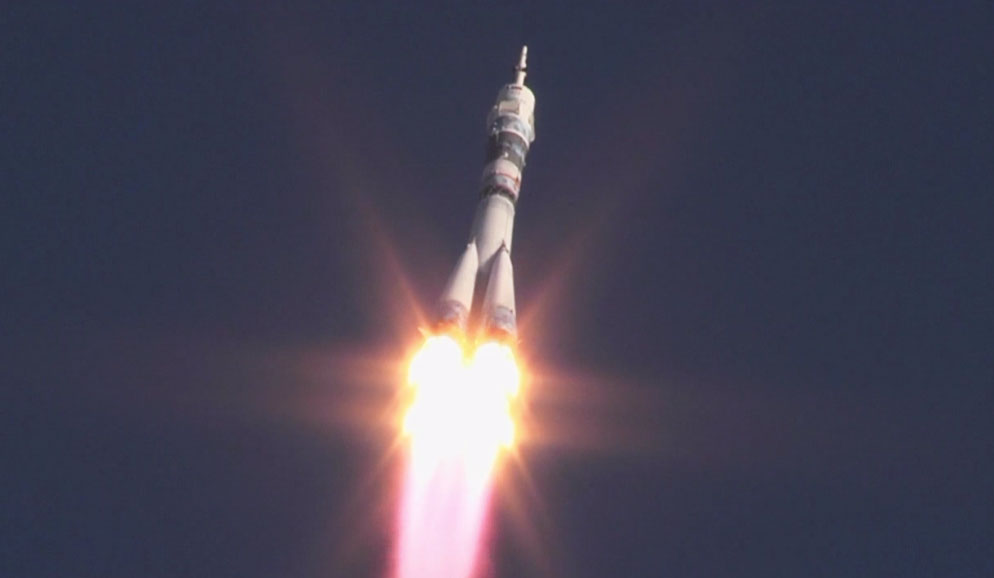
A second sun has risen above the Baikonur Cosmodrome in Kazakhstan, with the spectacular launch of Soyuz TMA-11M and three new resident crew members for the International Space Station (ISS). Liftoff occurred precisely on time at 9:14:28 a.m. local time Thursday, 7 November (11:14:28 p.m. EST Wednesday, 6 November). At the time of writing, Russian cosmonaut Mikhail Tyurin, NASA astronaut Rick Mastracchio, and Japan’s Koichi Wakata are midway through a six-hour, four-orbit rendezvous profile, preparing for a docking at the space station’s Earth-facing (or “nadir”) Rassvet module at 3:31 p.m. Baikonur time (5:31 a.m. EST) Thursday.
With the prime crew and their backups—Russian cosmonaut Maksim Surayev, NASA astronaut Reid Wiseman, and Germany’s Alexander Gerst—having traveled from the Star City training center on the outskirts of Moscow to Baikonur in Kazakhstan in late October, the final preparations for today’s launch proceeded exceptionally smoothly. On Monday, 4 November, technical managers met under the chairmanship of RSC Energia President and General Designer Vitali Lopota to unanimously authorize the rollout of the Soyuz vehicle in a horizontal configuration out to the launch pad. Early Tuesday, beautifully illuminated by the morning sun, the rocket made its final journey before space and was elevated into a vertical position on the pad.
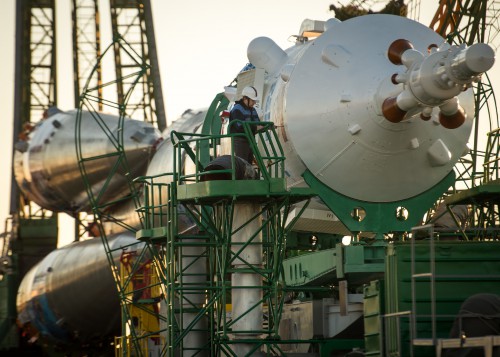
Shortly after 6:30 a.m. local time Thursday (8:30 p.m. EST Wednesday), clad in their Sokol launch and entry suits, Tyurin, Mastracchio, and Wakata were spotted departing the bus at the base of the pad. The three men were soon aboard the spacecraft, with Tyurin in the center seat, flanked by Mastracchio to his left and Wakata to his right. With the calming strains of Vivaldi piped into the cabin at one stage, the final two hours of pre-launch preparations ran like clockwork. The rocket was transitioned to its internal guidance system, and at T-40 minutes the servicing tower was retracted, exposing the bright colors of its Sochi 2014 Olympics mural.
Fueling with refined rocket-grade kerosene (RP-1) and liquid oxygen concluded and moved into a “topping-off” mode, thereby ensuring that cryogenic boil-off was rapidly replenished until shortly before launch time. This ensured that the liquid oxygen tanks were maintained at Flight Ready levels, ahead of the ignition of the rocket’s first stage engines. In the final quarter-hour, the Launch Abort System (LAS) will be armed and switched to Automatic Mode, and at T-5 minutes Commander Tyurin’s controls were activated and the crew was instructed to close their visors. Internal avionics were initiated and on-board flight recorders were spooled-up to monitor the vehicle’s myriad systems.
Inside the control bunker, the “launch key” was inserted at T-5 minutes, effectively enabling the ordnance to support Soyuz TMA-11M’s ascent, and the final phase of the countdown saw the completion of nitrogen purging, the pressurization of tanks, and the topping-off of cryogenics. At T-10 seconds, the turbopumps on the central core and the four tapering strap-on boosters awoke and the engines were confirmed at full power, producing a retraction of the fueling tower and a perfect, on-time liftoff. This was the first piloted Soyuz launch to occur in the hours of daylight since October 2012.
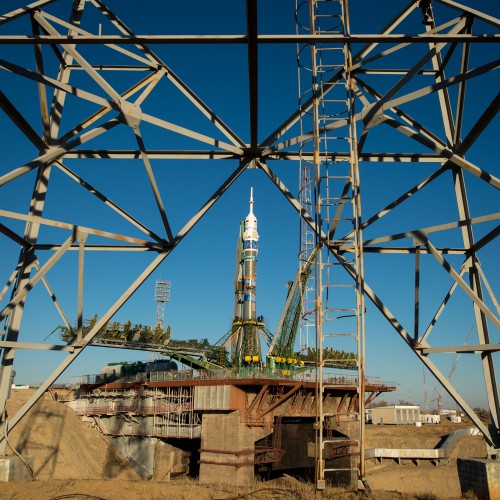
“Liftoff of the Soyuz rocket and the TMA-11M spacecraft,” exulted NASA’s commentator, “on a truly Olympic leap, delivering three more crew members to the International Space Station, on a historic mission to continue the seamless transition of humans on their own relay to continue studying science in space.” Rising rapidly, the vehicle passed 1,100 mph (1,770 km/h) within a minute of liftoff, producing a clipped “Flight nominal” from the Russian announcer. At T+118 seconds, at an altitude of about 28 miles (45 km), the four tapering strap-on boosters exhausted their propellant and were jettisoned, leaving the central core and its single RD-108 engine to continue the ascent. By two minutes into the flight, the vehicle was traveling at over 3,350 mph (5,390 km/h).
The payload shroud and escape tower were jettisoned shortly afterward, and, some 4 minutes and 58 seconds after leaving Baikonur, the core separated at an altitude of 105 miles (170 km) and the third and final stage ignited to boost Tyurin, Mastracchio, and Wakata to a velocity in excess of 13,420 mph (21,600 km/h). By the time that the third stage departed the vehicle, nine minutes into the flight, the crew was in space. Aboard the spacecraft—and serving as an indicator of the onset of weightlessness—was a small polar bear mascot for the Winter Olympics, which begin in February 2014 in the Black Sea coastal city of Sochi. In addition to the mascot, and the garishly-painted payload shroud mural, Soyuz TMA-11M is carrying a modified Olympic torch, which will be symbolically carried outside by Expedition 37 cosmonauts Oleg Kotov and Sergei Ryazansky during a spacewalk on Saturday, 9 November, then brought back to Earth by Fyodor Yurchikhin, Karen Nyberg, and Luca Parmitano aboard Soyuz TMA-09M on the night of Sunday, 10 November.
The launch of the new mission was broadcast live on the dual LED displays of the large Toshiba Vision screen in New York’s Times Square. “The space station serves as a unique laboratory for researchers around the world, home to astronauts from multiple countries, and it was built with international co-operation,” said William Gerstenmaier, NASA’s Associate Administrator for Human Exploration and Operations, “so it’s fitting to show the launch of the next crew in the most cosmopolitan city in the United States.” Broadcasting NASA Television coverage from Baikonur, the screen covered the event from 10:15 p.m. EST Wednesday—about an hour ahead of launch—until 11:45 p.m. EST, by which time Tyurin, Mastracchio, and Wakata had achieved orbit.
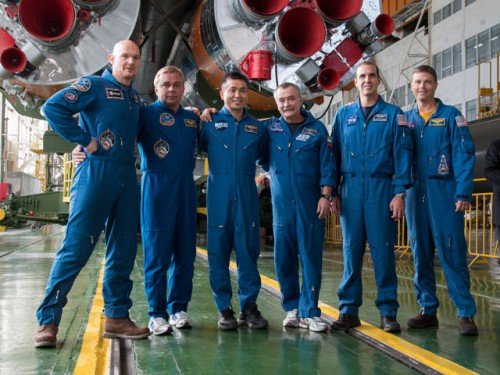
Two computer-guided “burns” of Soyuz TMA-11M’s maneuvering thrusters took place within the first 90-minute orbit of Earth, with several others to follow over the next couple of hours. According to Spaceflight101, docking with the ISS is scheduled for 3:31 p.m. Baikonur time (5:31 a.m. EST) Thursday, about six hours and 17 minutes after launch. In the aftermath of capture, a complex series of pressure and other checks will be conducted to verify the integrity of the seal between the two space vehicles. Hatch opening is anticipated at 7:40 a.m. EST, a little over two hours after docking, and Tyurin, Mastracchio, and Wakata will undoubtedly be engulfed in hugs from the incumbent Expedition 37 crew.
And that event will make for a crowded home in space. For the first time since the end of the shuttle era, no fewer than nine people—Commander Fyodor Yurchikhin of Russia, together with fellow Russians Oleg Kotov and Sergei Ryazansky, NASA astronauts Karen Nyberg and Mike Hopkins, and Italy’s Luca Parmitano, together with Tyurin, Mastracchio, and Wakata—will be aboard the multi-national outpost at the same time. Under normal circumstances, six-person ISS crews follow an “indirect” rotation protocol, whereby a given three-member subset departs the station, temporarily reducing the population to three, after which another crew arrives a couple of weeks later to restore it back up to six people.
The addition of the ceremonial Olympic torch task obliged ISS Program managers to look at conducting their first direct rotation since October 2009 and this poses difficulties, both in terms of the station’s life-support capabilities and day-to-day practicalities. “It will be a very interesting period of time on-orbit,” Oleg Kotov told a NASA interviewer before his launch on 25 September. “We have not had a direct handover for a pretty long period of time, so nine people will be working on-board the station at the same time. It requires a lot of co-ordination by the commander of the crew. It is like … a situation when a lot of your relatives arrive at your house. Somebody is unpacking. Somebody is just arriving. Somebody is leaving. Somebody is in the backyard planting something. After this work we will need a day or two to relax and to understand what happened.”
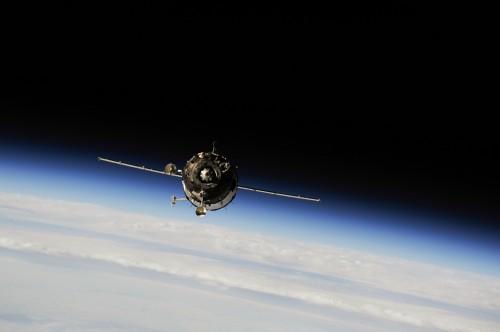
As part of preparations for the arrival of a third Soyuz spacecraft at the station—which currently plays home to Soyuz TMA-09M, launched in May, and Soyuz TMA-10M, launched in September—a relocation of vehicles was performed on Friday, 1 November. Yurchikhin, Nyberg, and Parmitano boarded their TMA-09M craft and undocked it from Rassvet, then performed a 21-minute “flyaround” to redock with the aft port of the Zvezda module. Meanwhile, Soyuz TMA-10M remains docked to the space-facing (or “zenith”) Poisk module. The relocation thus opens up Rassvet for the arrival of Tyurin, Mastracchio, and Wakata. ISS Program managers prefer to utilize the nadir Rassvet and zenith Poisk modules for Soyuz vehicles, in order that the Zvezda aft port (which lies on the station’s longitudinal axis) can be occupied by Progress or Automated Transfer Vehicle (ATV) cargo ships for reboost purposes. Since Soyuz TMA-09M is scheduled to depart the ISS on 10 November, and the next Progress is not due to launch until 25 November, its brief presence at the Zvezda aft port does not pose any visiting vehicle traffic complications.
In the aftermath of today’s Soyuz TMA-11M docking, there will be little time for Tyurin, Mastracchio, and Wakata to get acclimatized, for at 9:30 a.m. EST on Saturday, 9 November, Kotov and Sergei Ryazansky will venture out of the Pirs airlock into the vacuum of space for an ambitious and highly symbolic spacewalk. The most publicly visible objective of EVA-36—the 36th spacewalk to be performed from the station’s Russian Segment—is to carry a modified version of the chrome-and-red Sochi Olympic torch into the airless void.
Ceremonially lit in Olympia, Greece, on 29 September, its Russian relay began on 7 October in Moscow’s Red Square and will travel through 2,900 towns and villages, ahead of its arrival at the Black Sea coastal city of Sochi for the official start of the Games on 7 February 2014. Kotov’s daughter and Ryazansky’s wife are participating in the Olympic relay on the ground. For its “space” leg of its relay, the torch looks similar to those used on the ground, albeit with several modifications. “An open flame in space would be dangerous,” explained Spaceflight101, adding that “the torch will feature a simulated flame. Another modification made on the flight model and its backup that is already aboard the station is the addition of a safety tether.”
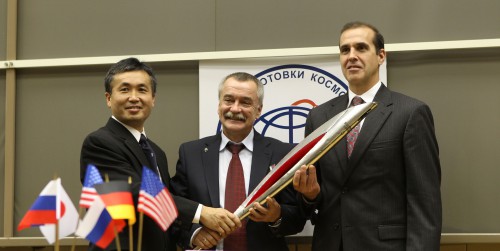
Grappling the modified torch in their gloved hands, Kotov and Ryazansky plan to take a number of photographs, possibly with Sochi as the backdrop. Several other exterior maintenance tasks are also planned. Originally, much of the work of Russian spacewalkers over the next few months involved communications, data and Ethernet cable installation, and reconfiguration in support of the launch of Russia’s long-delayed Multi-Purpose Laboratory Module (MLM)—originally planned for December 2013, then April and September 2014—but its recent postponement until no earlier than September 2015 has forced changes to be implemented. Planning remains in flux, but it appears at present that Kotov and Ryazansky’s EVA on 9 November may be one of only two spacewalks scheduled for the ISS for at least the next six months. Another excursion, EVA-37, also by Kotov and Ryazansky, is provisionally scheduled for 16 December.
Although Kotov has performed three EVAs during his two previous ISS missions in 2007 and 2009-2010, it will be Ryazansky’s first chance to savor the experience of spacewalking. “The first task is to take the Olympic torch to space,” he explained to a NASA interviewer before his launch with Kotov and Mike Hopkins in September. “The second task is to remove and replace a couple of antennas and to install some antennas in a different place. During EVA-37, we are planning to install new hardware called a chamber of high resolution, which later we will send back to Earth. We need to prepare the work stations for that by de-installing a couple of things, installing some new hardware and then we will be able to install two telescopes and point them to Earth.”
With the ceremonial brandishing of the Olympic torch on 9 November, Kotov and Ryazansky will bring the symbol of the Games back inside the ISS, and the process of packing it aboard the Soyuz TMA-09M descent module for its return to Earth will commence almost immediately. Expedition 37 Commander Fyodor Yurchikhin will relinquish command of the station, and Kotov will formally take over his duties, marking the start of Expedition 38. Yurchikhin, Karen Nyberg, and Luca Parmitano—who have been aboard the space station since late May—are slated to board Soyuz TMA-09M and undock from the Zvezda module at 6:26 p.m. EST Sunday, 10 November. Three hours later, following a fiery plunge through the atmosphere, they will touch down on the desolate steppe of Kazakhstan, concluding 166 days in orbit.
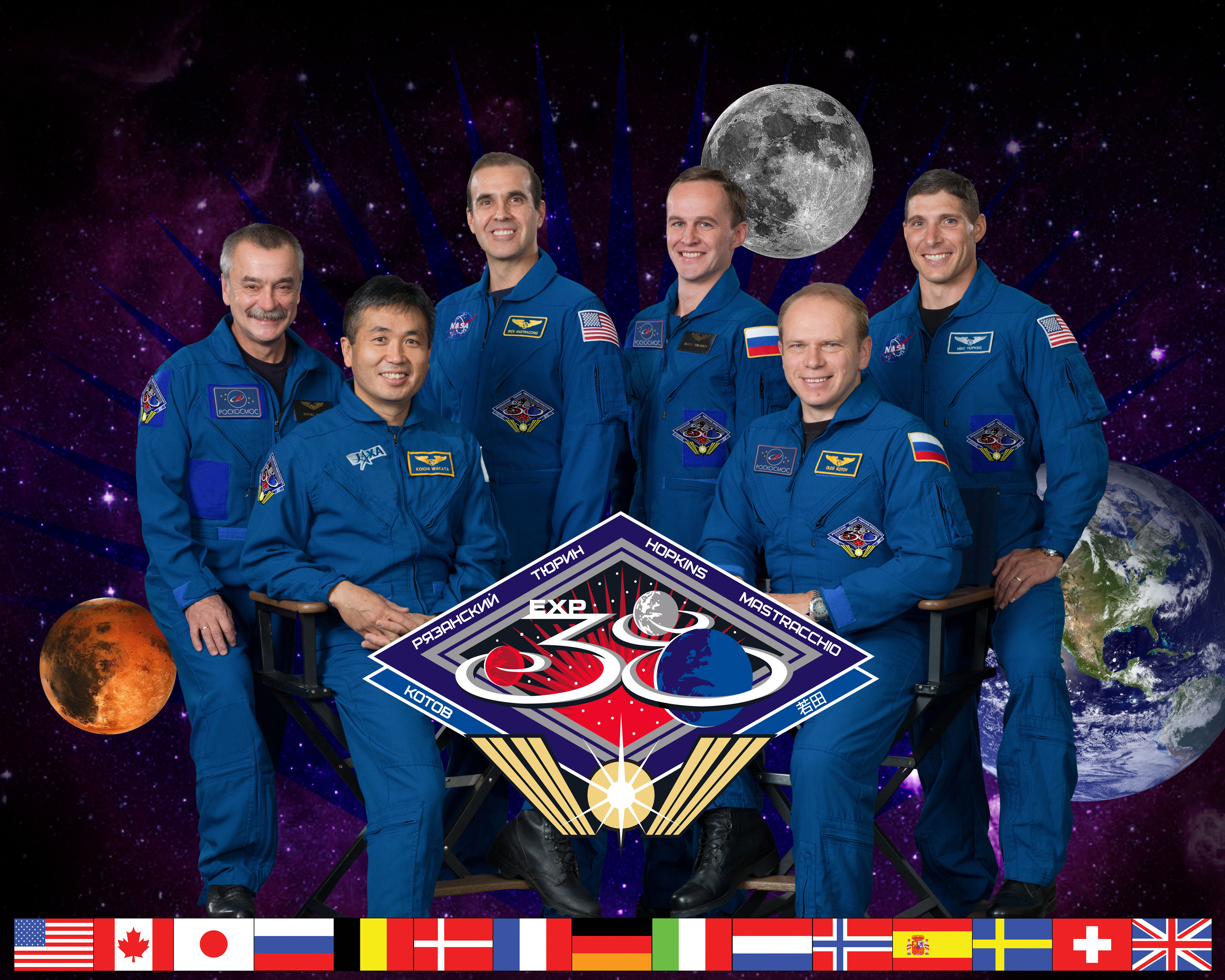
A military surgeon by training, Kotov has made no secret of the fact that he intends to share his experiences and devote as much time to educational outreach as possible during his expedition. “I will have more responsibility,” he admitted of his new role as skipper of the ISS until mid-March 2014. “The only difference here is that you are more responsible for the crew and for the station, but you are performing the rest of the work, so you have no privileges here. You do not have special food or special drinks. I think the commander has to be one step ahead of the crew and undertake the most difficult and maybe the most responsible assignments of the crew.”
Looking ahead to the manifest for Expedition 38, the first visiting vehicle is Progress M-21M, an unmanned supply craft which is scheduled to launch from Baikonur on 25 November. Unlike several other Progress vehicles, which have followed a six-hour rendezvous profile, this mission is expected to spend four days in transit to the station, completing a series of tests of its Kurs-NA rendezvous hardware. Its engines will provide a reboost of the ISS orbit in the first week of December, after which all eyes will turn to the Mid-Atlantic Regional Spaceport (MARS) on Wallops Island, Va., where Orbital Sciences Corp. plans to launch its first dedicated Cygnus cargo ship under a $1.9 billion Commercial Resupply Services (CRS) contract with NASA. Liftoff of the ORB-1 mission, atop Orbital’s home-grown Antares booster, is expected as early as 15 December.
Assuming an on-time launch, ORB-1 will rendezvous with the ISS on 18 December, following a similar profile to that adopted by the highly successful ORB-D Demonstration Mission in September. It will spend about three weeks berthed at the nadir port of the Harmony node, with its departure currently planned on 17 January 2014. Less than a month later, on 11 February, SpaceX—NASA’s other CRS partner, which holds a $1.6 billion contract to deliver supplies aboard its Dragon cargo ship—will despatch its third dedicated mission, dubbed “SpX-3,” from Cape Canaveral Air Force Station, Fla. Berthing at the Harmony nadir port on 13 February, Dragon will spend a month attached to the station, with its departure anticipated in mid-March. Unlike Cygnus, which is intended to burn up in the atmosphere at the end of each mission, Dragon ships have the capacity to complete a parachute-assisted ocean splashdown.
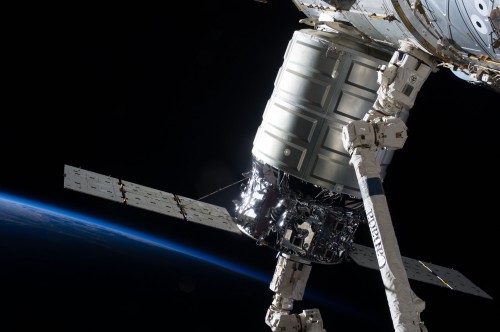
The primary payload aboard the SpX-3 mission is the Optical Payload for Lasercomm Science (OPALS), a new communications technology demonstrator which might someday improve spacecraft data rates by a factor of 10-100. It will operate aboard the space station for about three months. “It’s like aiming a laser pointer continuously for two minutes at a dot the diameter of a human hair, from 30 feet away, while you’re walking,” explained systems engineer Bogdan Oaida of NASA’s Jet Propulsion Laboratory (JPL) in Pasadena, Calif. Also aboard SpX-3 will be the High Definition Earth Viewing (HDEV) experiment to observe the Home Planet from multiple angles using four high-definition cameras. The SpX-3 flight will also be the first Dragon to rise atop SpaceX’s new Falcon 9 v1.1 rocket, which boasts uprated Merlin-1D engines and staged its inaugural mission on 29 September from Vandenberg Air Force Base, Calif.
With Kotov, Ryazansky, and Mike Hopkins due to board Soyuz TMA-10M and return to Earth on 12 March—completing a 168-day mission—the station’s population will be temporarily reduced to just three occupants: Tyurin, Mastracchio, and Wakata. Shortly before his departure, Kotov will hand command to Wakata, who will become the first Japanese to lead an ISS expedition. Two weeks after the departure of Kotov’s crew, on 26 March 2014, Soyuz TMA-12M will roar aloft from Baikonur, carrying Russian cosmonauts Aleksandr Skvortsov and Oleg Artemyev and NASA astronaut Steve Swanson. This will expand Wakata’s Expedition 39 crew to its full six-man strength.
“Japan is very happy to have this opportunity to have the ISS Commander from the Japanese astronaut corps,” said Wakata in his pre-flight NASA interview. “It is a big challenge for me and I am just fortunate to be able to learn a lot from my previous ISS commanders and shuttle commanders.” Recalling Brian Duffy—who commanded his STS-72 and STS-92 shuttle flights—as well as Lee Archambault and Mark Polansky and Russian cosmonaut Gennadi Padalka, with whom he flew at various stages during his 138-day mission in March-July 2009, Wakata has paid tribute to their leadership qualities and mentorship. “They are great leaders,” he said, “they pay attention to details, they listen well, they delegate tasks and they are wonderful communicators with the Mission Control Center folks. I just want to be like them and I was very fortunate to be able to experience and to learn from these wonderful leaders.”
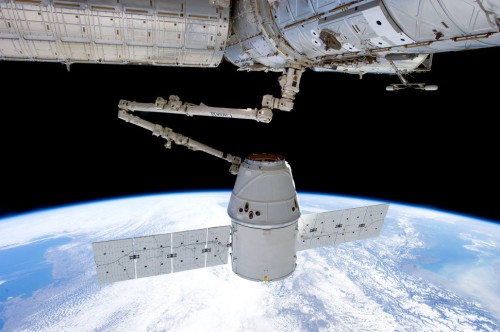
On a practical, day-to-day basis, Wakata expects that he will continue many of his flight engineer duties from Expedition 38 into his new role at the head of Expedition 39. “In addition to that, I will be taking the lead as the point of contact in the communications, daily and weekly, with the Mission Control Centers throughout the world,” he said, “and also the program management of the International Space Station in the different countries. I need to make sure that everybody in the crew is in a healthy condition and safety comes first and efficiency and also the happiness of the crew members. I’m just fortunate to be able to fly with such talented and dedicated crew members.”
As noted in a recent AmericaSpace article, the final days of Tyurin, Mastracchio, and Wakata’s mission may feature the arrival of another SpaceX Dragon craft. Present plans call for SpX-4 to launch on 29 April, transporting the Cosmic Ray Energetics and Mass (CREAM) instrument into orbit to analyze high-energy cosmic radiation from a perch on the Exposed Facility of Japan’s Kibo laboratory. With the undocking of Progress M-21M and the arrival of Progress M-23M also scheduled for late April, Expedition 38/39 is shaping up to be a busy increment, dominated by regular deliveries and science.
Want to keep up-to-date with all things space? Be sure to “Like” AmericaSpace on Facebook and follow us on Twitter: @AmericaSpace




